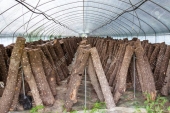
 1
1





 2
2




 2
2








 3
3




 2
2




Check out Redhawk's soil series: https://permies.com/wiki/redhawk-soil
 1
1




 1
1









 3
3




 1
1










 2
2




 3
3








 1
1




 2
2




 1
1




 1
1




 1
1




i tried inoculating fresh willow and it never took but the aspen i cut and did at the same time produced. it takes a long time for willow to die. the ones i had, put out new growth for 3 months. probably why the mycelium never took. maybe if you set the logs in a dry place till it stopped producing shoots, then soaked to rehydrate, then inoculated . willow would be ok. but until it completely dies ,the wood produces antifungals that keeps the wood fungus free.Adam Pickatti wrote:If you are plugging willow logs you should do so a week or two after cut while still wet, avoid ground conduct while colonization is happening and you should be fine( never grown on willow logs before). I usually get chips that have willow mixed in from the dept of transportation. I spread them out for about a week before I innoculate to let the anti fungal properties dissipate, during this time most of the the willow dries out enough to not root. After the pile is innoculated I keep an eye out for fresh willow growth and put those pieces that didnt dry out in direct sun where they can be dried the rest of the way.




 1
1




-




 1
1








 1
1




hybrid poplars also grows really fast. would be better for mushrooms but you don't get the other benefits. id chip the willow after its dried and make oyster mounds in a shady spot. they will produce in 6 weeks. you won't have big wood anyway right? if the logs aren't at least 5-6in. its not worth doing logs as they dry out too easily.Dave Green wrote:thanks Steve/Edward, this is all great information
If I was planning on doing short rotation coppice, do you think I am risking it a bit by counting on willow logs for innoculating with funghi, due to their anti fungal properties? I was going to mix the coppice with poplar and hazel but was going to focus on willow as they seemed to have the most potential for sellable produce (basketry supplies, rods for gardeners, floristry/decorative) as well as being easy as hell to propagate.
thanks
 1
1




Dave Green wrote:thats great advice, thanks Steve
because they are in a building, will there be less chance of other funghi colonising it?[/quote yes. and keep them dry.




 1
1




Dave Green wrote:thats terrific Henry, thank you
I now have a decent list of different mushrooms to try. I am going to trial some of this on my allotment if I can get hold of some willow logs/chips
-




 1
1




it could be done but you would have to fuss over them all the time. i think if willows chipped, a week later should be able to inoculate w/ oyster spawn. I've taken wine cap colonized wood chips and put them in between my raspberry rows about 2-3in. thick . then covered w/ a half inch or so of fresh sawdust and kept moist. got quite a bit of mushrooms that way. got to make sure the chips are completely white w/ mycelium though. works good in between mounds of potatoes too!Henry Jabel wrote:
Dave Green wrote:thats terrific Henry, thank you
I now have a decent list of different mushrooms to try. I am going to trial some of this on my allotment if I can get hold of some willow logs/chips
If you are growing it in your allotment you might want add some innocullated chips to your veg beds. In mycellium running there is a section where it compares companion veg and fungi. The best combination is Elm oyster (Hypsizygus ulmarius) with brussel sprouts and brocolli x4 the total yield (fungi and veg) weight of the unmulched control.
The wine caps also significantly increased production too but fruit one or to years after establishment. The good thing about the winecaps too from my experience is they can tolerate disturbance very well which is obviously useful in veg beds.
The only diminished effect on the plant growth was produced by oyster (Pleurotus ostreatus) but the total yield of fungi and plant was greater than the controls. So best to keep the oyster to log cultivation.
 1
1




 1
1








 1
1




 4
4








If there is one thing the Wizard of Oz has taught me, it is not to trust school teachers on bicycles.




Catherine Maguire wrote:I have inoculated a fresh willow branch with King Oyster mushroom plugs, and have it in a shady wet spot, but the branch is still producing new growth buds. If I break off the new growth, should I keep it in the damp moist position or try to dry it to stop the new growth - if I do move it to a sunny dry position will the mushroom spores survive?
What is the best advice?
Also I have some Shitake mushroom spores, should I use dried out but cut within last moth willow or some slightly rotting timber I also have?
-

| I agree. Here's the link: http://stoves2.com |




